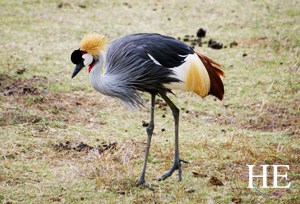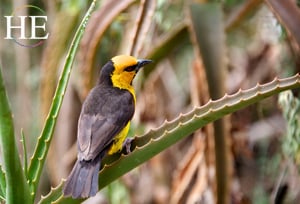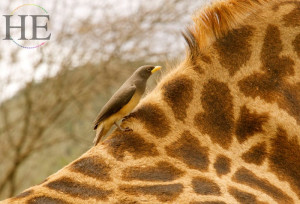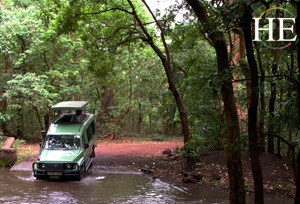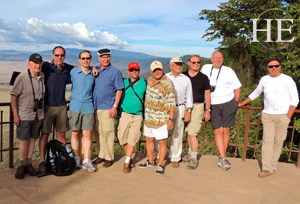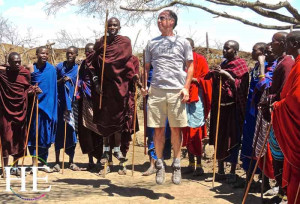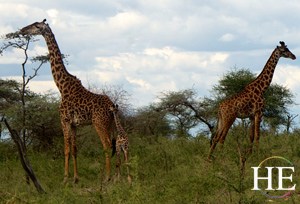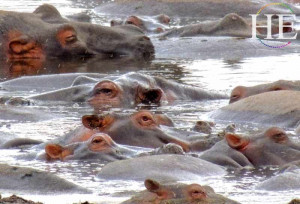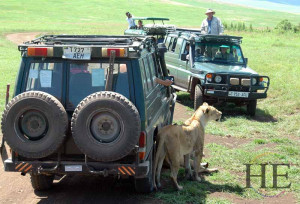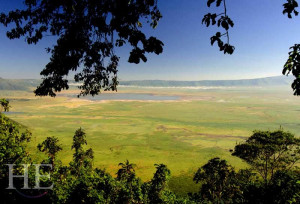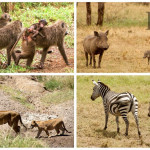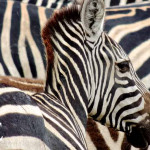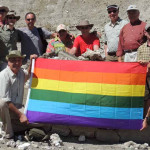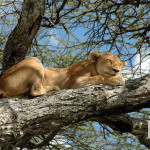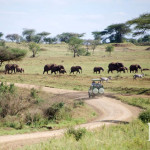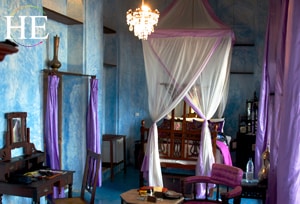- Experience the true Africa – Tanzania has more land devoted to wildlife than anywhere else in the world.
- Spend each night at unique Serena (or similar) bush lodges and tented camps.
- Visit Lake Manyara, home to vast flocks of flamingos and other colorful birds.
- Gaze out on the Ngorongoro Crater from our lodge on the rim of this extinct volcano from the floor-to-ceiling windows for amazing views of this Garden of Eden.
- Descend 2,000 feet to the crater’s floor and look for the rare black rhino.
- Breathe the pristine air that our most distant human ancestors breathed at the Olduvai Gorge where the Leakey’s made their great archeological discoveries.
- Spend four days gazing out on the vast Serengeti Plain from a remote lodge and a tented camp.
- See wildebeests, zebras and elephants gathering around watering holes, and learn what what elands and oryx’s are.
- View lions stalking their prey along rivers and hippo pools.
- Return to our starting place by light aircraft for a final view of this unique landscape.
- Join our optional extension to the mysterious Indian Ocean island of Zanzibar (the “Zan” of Tanzania, along with the former country of Tanganyika).
Walk on the wild side in Tanzania! This gay safari hits all the best spots, from Lake Manyara, often appearing pink from a distance due to flocks of flamingos, to the expansive savannas of the Serengeti. See the roots of man in Olduvai Gorge, and the unique eco-system of Ngorongoro Crater.
Tanzania is a slice of the true Africa where the animal rules supreme and the land is free of the encroachment of modern civilization. Tanzania has more land devoted to wildlife than anywhere else in the world. For the Safari aficionado Tanzania is a true paradise.
ITINERARY
Departing Home
Most North American travelers will depart home a day before the first day of the tour. See our FAQ about flights to see the variety of options available to Kilimanjaro and home from Kilimanjaro or Zanzibar or Dar es Salaam for those on the extension.
Day 1: Arusha
Upon arrival at Kilimanjaro Airport, you will be met by our representative and transferred to our hotel near Arusha, about 30 miles from Kilimanjaro Airport. You can enjoy the balance of the day at leisure.
Located on a coffee plantation on the shores of Lake Duluti, our lakeside resort is the perfect place to relax before embarking on your safari experience. The lodge boasts magnificent views of the mighty snow-capped Mount Kilimanjaro on one side and Lake Duluti and the rugged peaks of Mount Meru on the other. Meet your other tour members for an early evening reception. Dinner is on your own tonight, since some of the most convenient flights arrive later in the evening.
Days 2-3: Lake Manyara National Park
Today we drive to Lake Manyara National Park, an ornithological paradise with over 350 species of birds. You may see Verreaux’s Eagle, and a variety of vultures, storks, swifts and swallows winging their way among the spectacular cliffs overlooking the lake. The lake often has a pinkish hue due to the flamingos, pelicans and storks shimmering in the distance.
Lake Manyara, at 3,150 feet in altitude, varies in salinity levels with wetter and drier climate cycles. Springs in the park’s northern end support a dense groundwater forest of magnificent giant fig and mahogany trees which shelter blue and vervet monkeys and an abundance of baboons, bushbuck, waterbuck, and elephants. South of the groundwater forest, acacia woodland and open grassland are frequented by buffalo, wildebeest, impala, giraffe, zebra, and the elusive tree-climbing lions – the signature of this park.
Perhaps the most recognizable tree found here is the baobab tree, which folklore says was uprooted and planted upside down. The hippo pool, where visitors may get out of their vehicles, is located on a freshwater stream that enters the lake at its northern tip.
Our accommodation is on the edge of the Mto Wa Mbu escarpment, overlooking the Great Rift Valley and the stunning Manyara soda lake. The great birds of prey that glide on thermals below your balcony inspired the design of the lodge – swooping curves are complemented by soft, geometric patterns and stylish murals depict bird migration patterns. All rooms have private balconies overlooking the escarpment and the lake beyond. We will enjoy our welcome dinner on our first evening at Lake Manyara.
Day 4: Traditional and Modern Life
Today we venture off to Gibb’s Farm for lunch. Gibb’s Farm is an oasis of green, calm and beauty, in a landscape that can often be parched, dry and dusty. This privately owned farm is renowned for its cuisine. The food is delicious, with fresh vegetables from the gardens cooked with care. Lunch includes a wide selection of savory pies and salads, served buffet style.
We will also visit a traditional Iraqw home. The Iraqw are the local tribe that has inhabited the Ngorongoro highlands for over two centuries. Their homes are built entirely using traditional materials and methods of construction, just as it would have been 200 years ago. You will see many of the tools and weapons used by the Iraqw. Try your hand at grinding maize the traditional way using grinding stones and listen to a presentation and demonstration of Iraqw skirt making. While here you will also have the opportunity to visit a more modern Tanzanian farm and observe a bio-gas plant used for producing gas for cooking and lighting.
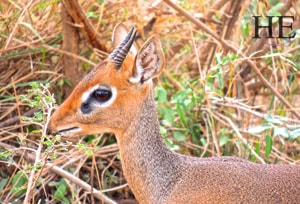
We will then continue on to the Ngorongoro Conservation Area and our home for the next two nights. As if in a land before time, our lodge is built at the rim of the crater. The plant and ivy-covered native stone blends masterfully with its surroundings and the flowering plants attract a plethora of colorful birds. Most of the rooms have private terraces with views of the crater floor where countless animals make their home. The goal of our lodge is for visitors to exist in harmony with the natural environment and the wildlife that inhabits it.
Day 5: Exploring the Ngorongoro Crater
In the early morning, board your Land Rover for an amazing journey as you descend onto the floor of the crater, which is an extinct volcano and the largest unbroken caldera in the world. The cone of this UNESCO World Heritage site is believed to have collapsed nearly two million years ago, and while the cone was standing, it could have been as tall as, if not taller than Mount Kilimanjaro.
The crater (1,800 feet deep and 102 square miles) is a microcosm of East African scenery with abundant wildlife including more than 25,000 larger animals, mostly zebra and wildebeest. This is also the best place in Tanzania to see magnificent black-maned lions. This area offers an outstanding opportunity to see black rhinos, as they are protected around the clock.
Over the years, the floor of this crater has become mostly savanna (grassland), with a soda lake whose size changes depending on the rains that are the lifeline of this amazing land. On this lake, marvel at the colorful flamingos and a variety of other water birds – more than 100 species of birds found here that are not found in the Serengeti. Resident Ostriches, Crowned Cranes, and Kori Bustards are joined seasonally by migrant flocks of White and Abdim’s Storks. Patience may also reward you with glimpses of leopard, cheetah, hyena, jackal, elephant, warthog, buffalo, impala, buffalo, hartebeest, eland and many other types of antelopes.
As you descend, you might be able to see the local Maasai as they take their cattle down the steep walls of the crater. It is their right, negotiated with the government and parks authority, to graze their cattle on about 75% of the crater floor. The mix of cattle with the wild animals makes for some terrific photographs, and interaction between domestic and wild animals is almost non-existent. Your wildlife-viewing will be dramatic, and the experience memorable. A recent HE Travel group had lions passing close enough to their vehicle to (almost!) touch them.
Return to the rim of the crater six hours later (regulations now specify that no one can stay longer than six hours daily on the crater floor) and drive to your lodge in time for a late lunch. In the afternoon, visit a Maasai village and learn about this fascinating culture that has existed through the millennia in harmony with nature.
Day 6: Olduvai Gorge – The Origins of Man
This morning we will drive to the legendary Olduvai Gorge. The drive to the gorge is breathtaking. We will pass through a spectacular mix of savanna and volcanic hills, where red-robed Maasai graze their cattle, before the road drops steeply down into the gorge itself.
The name originated from the Maasai word “ole” meaning “the place of” and “dupai” meaning “wild sisal,” a local plant resembling aloe which grows abundantly in the area. This plant has yellow-green, succulent, spear-like leaves which form dense clumps, binding the loose soil of the gorge and sheltering many other plants and animals. Domesticated sisal is used to produce rope, rugs and baskets which are sold at the local markets, and is one of the biggest exports of Tanzania.
The Olduvai Gorge is one of the world’s most important paleoanthropological locations. This is where, in 1959, Mary and Louis Leakey found fossil evidence of the 1.7-million-year-old Australopithecus Boisei (Zinjanthropus) and Homo Habilis (Handyman). Thousands of stone tools, some of which were used by Homo Habilis, have been found at Olduvai. The oldest style is easiest to remember, because it is called Oldowon.
In addition to the remarkable human fossils, enormous fossils of prehistoric elephants, giant-horned sheep and ostriches have been found here and extinct species unearthed here include three-toed horses and giant antelope. Since the Leakey’s first began searching the area for clues to our distant past, more than sixty hominid remains have been excavated, belonging to four different hominids, showing the gradual increase in brain size and in the complexity of their stone tools.
The gorge itself is a very steep-sided ravine roughly 30 miles long and 295 feet deep. It resembles a small Grand Canyon with exposed strata of different layers where the deposits of rich fauna fossils, hominid remains and stone tools were found. The gray lines are volcanic tuffs and evidence of eruptions is used to estimate the age of the fossils.
You will want to visit the museum which contains a cast of the 3.7 million-year-old footsteps of Australopithecus Afarensis preserved in solidified volcanic ash, found at nearby Laetoli by Mary Leakey in 1979. Outside the museum a Tanzanian guide will explain the geological features of the gorge and the work of the Leakey’s.
From the Gorge we will resume our drive to Serengeti National Park (3,646,500 acres), the jewel in the crown of Tanzania’s protected areas with over 3 million large mammals roaming its plains. It lies between Ngorongoro Crater and Lake Victoria and adjoins Kenya’s Maasai Mara.
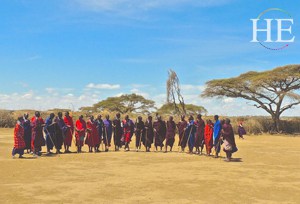
The Serengeti has come to symbolize paradise to all, including the local Maasai, who have grazed their cattle on the vast grassy plains for generations. To the Maasai, it is Siringitu – “the place where the land moves on forever.” Today, the Serengeti National Park, the Ngorongoro Conservation Area, and the Maasai Mara Reserve across the border in Kenya together protect the greatest and most varied collection of terrestrial wildlife on earth, and one of the last great migratory systems still intact.
Your home for the next two nights will be in a lodge with small bungalows built in the local style, and spread out enough for each to have a view of the surrounding terrain and its occupants. Each room is decorated in true African luxury style with mosquito nets, four-poster beds, and bathrooms with showers in each room. Your daily game drives will give you the opportunity to experience and appreciate first-hand the harshness and beauty of this area.
Day 7: Searching the Serengeti
Today we begin our in-depth exploration of the seasonal migrations which have made the Serengeti famous. Your twice-daily wildlife drives will allow ample viewing.
More than a million wildebeest, accompanied by hundreds of thousands of zebras and other herbivores, descend upon the short-grass plains of the southeastern Serengeti at the start of the rainy season around December. After calving in January and February, they scatter over the southern and central plains. By May the rain ends, the grass has been reduced to stubble, and the animals begin their long march to dry-season grazing grounds near the permanent waters of the Serengeti’s northern woodlands and Kenya’s Maasai Mara. Reaching these destinations by July or so, they remain until October, when they head back to the southeastern Serengeti. This struggle for survival continues unaided and unaltered through the millennia!
The Serengeti is incredible to visit any time of the year. In the Seronera Valley towering yellow fever trees and palm thickets line the Seronera River and its hippo pools. This is a superb area for seeing predators such as lion, leopard and cheetah, and their prey – giraffe, topi, Bohor reedbuck, Defassa waterbuck, buffalo and impala. The kopjes (prehistoric rock outcroppings) host hyraxes, dwarf mongooses, and red-headed agamas, while patience might reward you with a sleepy black-maned male lion or leopard.
The open grassland is home to large groups of Thomson’s and Grant’s gazelles, spotted hyena, jackal, and such birds as the Double-banded Courser, Yellow-throated Sandgrouse, Red-capped Lark, Fischer’s Sparrow-lark, and Capped Wheatear.
As an optional excursion, you can take a dawn balloon safari for an exhilarating view across the savanna as the early sun rises and the animals are more active.
Days 8-9: Serengeti Western Corridor’s Grumeti River Basin
We will enjoy our next wildlife drive as we traverse the pristine Serengeti to our next accommodation. This drive is in the famed Grumeti River area in the Western Corridor, a picturesque part of the Serengeti. The drama of the most intense part of the migration unfolds April through June and into July, but there is a substantial amount of wildlife that inhabits this region throughout the year.
This is a truly beautiful area to spend two nights and you’re sure to find some kopjes (rocky outcroppings) on which to enjoy your sundowners while watching the panorama that unfolds before your eyes. Grumeti is famous for huge crocodiles and for hippo pools, and you’ll get an opportunity to see both.
Your accommodation for the next two nights will be at a very comfortable tented camp, a reincarnation of an elegant Victorian era outpost, set against the imposing backdrop of the Western Serengeti. Here, guests experience Africa’s majesty as if they are among the first to travel these extraordinary lands. Set upon a hill with commanding views of the endless savanna, our camp will beckon you to experience the soul of the African wilderness.
The camp is built in a remote stretch of the Grumeti River and is home to a wide variety of big wildlife, such as lions, buffalo, cheetahs, wildebeests, giraffes, baboons and gazelles. From almost anywhere, there are spectacular vistas of the Serengeti stretching to the horizon. Our camp’s carefully landscaped grounds are designed to blend with their natural surroundings. Guests enjoy the highest standards of personalized attention, accommodation, meals and service.
Day 10: Farewell or join the Optional Extension to see Zanzibar
This morning we’ll have a last chance to photograph the awesome sunrise then enjoy our last breakfast in the bush. Over the past week we’ve worked our way westward from Arusha to Lake Manyara to Ngorongoro Crater to Olduvai Gorge to the magnificent plains of the Serengeti. This morning we will retrace our steps, but from the unique vantage point of a light aircraft, giving aerial views of the landscape we have traversed on the ground.
Our aircraft will take us back to the Arusha airport. Time permitting, we’ll have an opportunity to shop at Arusha’s Cultural Heritage Center before relaxing at your dayroom back at our lodge where you can freshen up before evening flights. A transfer will be provided to Kilimanjaro Airport in time for flights back home.
Or if you have a few extra days to see a completely different side of Tanzania, please join our optional extension to the nearby Indian Ocean island of Zanzibar (see Extension).
EXTENSION
Exploring Zanzibar
We will fly from Kilimanjaro Airport to Zanzibar, then spend three nights in a restored Swahili merchants home (now a B&B) in Stone Town, the main town on the island of Zanzibar. Being an off-shore island in the middle of the most important sea lanes on the African coast of the Indian Ocean, Zanzibar is home to descendants from several of the cultures surrounding this region, including black Africans, Omani Arabs, Jewish traders from the Red Sea, Indians, and Europeans.
Our lodging on Zanzibar is called Emerson Spice, and it has been lovingly restored by its American owner and his partners on the project. Each room is unique and features an open floor plan (curtains rather than walls around the en-suite bathroom facilities). On the roof is one of the finest restaurants in Stone Town, where we will dine during one of our evenings, watching the sun set over the African continent to the west.
During our stay on the island we will tour with a local guide to see the natural parts of the island, and also hear the tales of the people who have lived here over the centuries. We will also make a short trip out to sea on a dhow – a traditional wooden vessel.
Airport transfers will be provided on the last day based on flight times via Dar Es Salaam or Addis Ababa.
PRICING:
Price includes: Arrival and departure transfers between Kilimanjaro Airport and our Arusha lodge; Deluxe Serena Lodges and tented camps throughout the journey; American breakfast in Arusha, then all meals while on safari in Tanzania; Transportation between lodges in comfortable vehicles; Light aircraft flight from the Serengeti to Arusha at end of tour; Numerous game drives in private 4×4 vehicles driven by naturalist driver-guides; Complimentary bottled water in vehicles and during meals; Professional naturalist accompanying the group (with a minimum of six travelers); Professional Hanns Ebensten Travel tour director (with minimum participation); All applicable lodging taxes and gratuities for baggage handling; All park entry fees; Complimentary baggage tags. HE Travel provides complimentary Medical & Evacuation Insurance for every US Resident on our group tours who does not have other coverage.
Not included: Airfare between home and Kilimanjaro Airport; International departure taxes; Visa for Tanzania; Vaccination for malaria and routine vaccinations as recommended by your physician; Meals not included in tour package; Personal items including: alcoholic beverages, snacks, and telephone calls; Gratuities for guides and HE Travel tour director.
Optional Tour Choices:
$1800 Single Supplement (limited availability; for solo travelers who wish to enjoy a private bedroom and bathroom)
$575 Serengeti Ballooning
Zanzibar Extension
Price includes: Flight from Arusha to Zanzibar; Airport transfers; Three (3) hotel nights with breakfast each morning and two dinners; Half-day Stone Town excursion; Full-day land & water island excursion.
Not included: Meals not shown as included, gratuities for local guides and HE Travel host (host will accompany the group pending minimum participation)
$1490 Double Occupancy
$1790 Single Occupancy
Like this tour?
Very Helpful
By Rocky R trip to Anywhere
Did a great a job Kyle was able to Book my vacation exactly what I was Looking for and was very helpful
Popular Posts
- 8 Facts About the Panama Canal
- 10 Amazing Facts about the Tasmanian Devil
- Top 6 Wellness and Fitness Cruises You Should be Booking Now
- Where's the Only Restaurant in Alaska by a Michelin Starred Chef?
- Top 10 Reasons to Travel to Croatia
- Discover Tropical Romance in 3 Overwater Bungalow Resorts on the Caribbean Sea

